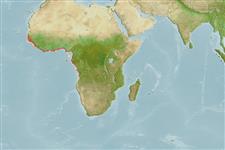Teleostei >
Gobiiformes (Gobies) >
Oxudercidae (Mudskippers) > Periophthalminae
Etymology: Periophthalmus: Greek, peri = around + Greek, ophthalmos = eye (Ref. 45335).
More on author: Linnaeus.
Environment: milieu / climate zone / depth range / distribution range
生态学
海洋; 淡水; 半咸淡水 礁区鱼类; 非产卵性溯降河的 (Ref. 51243). 熱帶; 25°C - 30°C (Ref. 1672); 21°N - 18°S, 18°W - 14°E
Africa: West-African coast, from Senegal to Angola (Ref. 57403, 79590), including most offshore islands - Macias Nguema, São Tomé, and Principe islands (Ref. 10814). Also reported from Mauritania (Ref. 5377). Western Central Pacific: Guam (Ref. 35720).
Reports from India (Ref. 29108), Thailand (Ref. 37773), Bangladesh (Ref. 39989), Philippines (Ref. 6956) and Australia (Ref. 38544) need confirmation.
非洲: 塞內加爾到安哥拉 (參考文獻 7390), 包括大多數的離岸島嶼 - Macias Nguema ,聖多美與普林西比島島.(參考文獻 10814)
Length at first maturity / 大小 / 重量 / 年龄
Maturity: Lm 9.6, range 8 - ? cm
Max length : 14.7 cm SL 雄鱼/尚未辨别雌雄; (Ref. 79590)
背棘 (总数): 11 - 15; 背的软条 (总数): 10-13; 臀棘 1; 臀鳍软条: 8 - 10. Diagnosis: large adult size, approaching 150 mm SL; head width 15.4-21.8% SL (Ref. 5218). Upper lip covered by a skin fold; anterior nostrils conical and tubular, reaching to level of lower lip; posterior nostrils small, slit-like (Ref. 57403, 79590). Snout deep (Ref. 3657). Mouth horizontal (Ref. 3657), large, its gape extending to below center of eye (Ref. 57403, 79590). Eyes protruding and close together with lower eyelid fold (Ref. 3657). Predorsal scales extending anteriorly to level of hind margin of eye; upper margin of operculum, preoperculum and sub-/infraorbital regions, as well as pectoral-fin bases, covered with small, cycloid scales; 86-107 scales in longitudinal series (including usually 3 or 4 scales on caudal fin base) (Ref. 5218, 57403, 79590). First dorsal fin high (Ref. 3657), with 10-14 spines (Ref. 57403, 79590) that are flexible (Ref. 3657). Second dorsal fin with 1 spine and 10-13 soft rays (Ref. 57403, 79590), its base longer than the distance from end to caudal fin origin (Ref. 3657), length of 2nd dorsal fin base 20.9-24. 1 %SL (Ref. 5218). Length of anal fin base 14.1-17.7% SL (Ref. 5218). Pectoral fins with a long muscular lobe (Ref. 3657). Pelvic fins joined by a transverse membrane connecting the bases of the 5th pair of segmented rays (Ref. 57403, 79590). Pelvic fin length 14.2-16.0% SL; no frenum uniting pelvic fins (Ref. 5218). Caudal fin asymmetrical, upper ray longest (Ref. 57403, 79590), lower rays shorter and stout (Ref. 3657). TRDB 20-34 (Ref. 5218).
Coloration: in life: fish olive-green or rusty-brown dorsally, paler ventrally; small, blue ocelli scattered over flanks and dorsum, and some oblique, black bands may be present on dorsal part of flanks (Ref. 57403, 79590). 1st dorsal fin is dark on its anterior margin and has a bright blue longitudinal band near its distal margin; 2nd dorsal fin has 2, narrow, bluish-white longitudinal bands on its upper half (Ref. 57403). Anal fin pale or white, and sometimes slightly mottled with fine, dark spots (Ref. 79590). Pectoral fins dark on outer (lateral) surface, with pale distal margins, and lighter on inner (medial) surface, particularly ventrally; pelvic fins whitish on ventral surface but darker on dorsal surface, with pale margins; caudal fin dark (Ref. 57403, 79590). Preserved specimens: dark brown/violet on head, dorsum and flanks; chin pale or mottled gray; ventral body surface pale whitish-yellow (Ref. 57403, 79590). 1st dorsal fin grayish with a black band near distal margin, bordered dorsally and ventrally by a narrow white band; 2nd dorsal fin with a brown margin and a black stripe running along upper portion of fin, this stripe bordered dorsally and ventrally by a narrow white band (Ref. 57403). Anal fin pale or white (Ref. 57403), sometimes slightly mottled with fine, dark spots (Ref. 57403). Caudal fin dark brown on its dorsal part, whitish on its ventral part (Ref. 57403).
眼以低的眼睑摺层伸出而且靠拢在一起; 深地的吻; 嘴水平的。 两个分开的背鳍, 第一个高的, 藉由 11根柔韧有弹性的棘, 第二个低的, 它的基底长度超过从末端到臀鳍起点的距离; 胸鳍有一个长的肌肉叶; 腹鳍越过基底联合了; 尾鳍有低的鳍条短, 与矮胖的。 色彩是褐色的有斜深色的横带,腹面颜色淡的; 背鳍具有一个宽的末梢部的纵向深色条纹与灰白的边缘。
Facultative air-breathing (Ref. 126274); Found on muddy substrates and in brackish waters of estuaries, lagoons and mangrove swamps (Ref. 79590). Occasionally found in freshwater, but always close to the shore (Ref. 57403, 79590). Amphibious air-breather (Ref. 31184) that skips or walks on sand or mud in search of food; that is, on exposed intertidal mud flats of estuarine mangrove swamps. Adult feed chiefly on arthropods (crabs, insects, etc.) of the mud surface. Also included in the diet is the white mangrove, Avicennia nitida (Ref. 3026). Spawn in burrows (Ref. 3657). Maximum reported total length 165 mm; reports of larger specimens, up to 250 mm TL, are probably misidentifications of other species (Ref. 79590).
跳跃或行走于沙或泥以找寻食物上的两栖的呼吸空气的鱼类 (参考文献 31184); 在河口红树林沼泽的暴露在潮间带淤泥平台上, ,那是。 主要捕食泥表面的节肢动物 (螃蟹,昆虫, 等等。) 。 也包含在食性内是白色的红树林, Avicennia nitida.(参考文献 3026) 产卵在洞穴。 (参考文献 3657) 可能被个别的猎捕捕获但是没有商业重要性目前。
Life cycle and mating behavior
成熟度 | 繁殖 | 产卵场 | 卵 | 孕卵数 | 仔鱼
Probably a multiple spawner (Ref. 58481).非洲: 塞內加爾到安哥拉 (參考文獻 7390), 包括大多數的離岸島嶼 - Macias Nguema ,聖多美與普林西比島島.(參考文獻 10814)
Harrison, I.J., P.J. Miller and F. Pezold, 2003. Gobiidae. p. 625-666 In C. Lévêque, D. Paugy and G.G. Teugels (eds.) Faune des poissons d'eaux douce et saumâtres de l'Afrique de l'Ouest, Tome 2. Coll. Faune et Flore tropicales 40. Musée Royal de l'Afrique Centrale, Tervuren, Belgique, Museum National d'Histoire Naturalle, Paris, France and Institut de Recherche pour le Développement, Paris, France. 815 p. (Ref. 57403)
人类利用
渔业: 自给性渔业; 水族馆: 商业性
更多信息
参考文献养殖养殖信息品种遗传学Electrophoreses遗传率疾病加工NutrientsMass conversion
工具
特别资料
下载 XML
网络资源
Estimates based on models
Preferred temperature (Ref.
123201): 25.1 - 28, mean 27.3 °C (based on 187 cells).
Phylogenetic diversity index (Ref.
82804): PD
50 = 0.5000 [Uniqueness, from 0.5 = low to 2.0 = high].
Bayesian length-weight: a=0.01072 (0.00710 - 0.01618), b=3.00 (2.88 - 3.12), in cm total length, based on LWR estimates for this species & Genus-body shape (Ref.
93245).
营养阶层 (Ref.
69278): 3.2 ±0.42 se; based on food items.
回复力 (Ref.
120179): 中等的, 族群倍增时间最少 1.4 - 4.4年 (K=0.89; Fec=2,100; assuming tm= 2.5 years based on growth curve).
Fishing Vulnerability (Ref.
59153): Low vulnerability (25 of 100).
